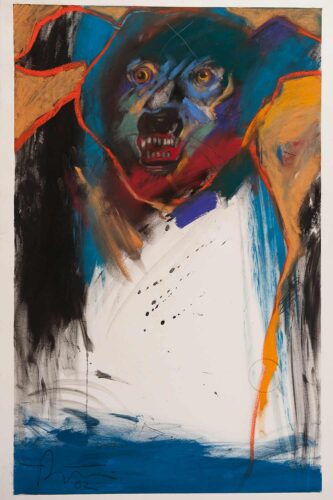
The late Rick Bartow might be Oregon’s most powerful artistic visionary. His strange, compelling paintings, drawings, prints and sculptures, with their animal and human faces, have been shown in galleries and museums around the world, not only earning accolades from arts professionals but drawing in ordinary people who are immediately captivated by his work.
The Karin Clarke Gallery downtown opened its largest Bartow exhibition yet on April 5. Rick Bartow: Myth/Reality, which runs through May 13, includes more than 30 of his paintings, drawings, prints and sculptures. It’s the fifth time the gallery has exhibited Bartow’s work, starting with a small show of prints in 2015 that accompanied a major retrospective, Things You Know But Cannot Explain, put together by the Jordan Schnitzer Museum of Art. The Schnitzer show traveled to 11 other museums and art centers around the country, including the Heard Museum in Phoenix and the Autry Museum of the American West in Los Angeles.
“This is our largest, our most potent exhibit of his work,” says gallery owner Karin Clarke of the show now running at her gallery. “And it includes pieces from the Schnitzer exhibit.”
An enrolled member of the Mad River band of the Wiyot Tribe in Northern California, Bartow was born in Newport in 1946 and studied art education at Western Oregon University, where he graduated in 1969. Drafted into the Army, he served as a teletype operator in Vietnam; there he earned a Bronze Star for playing rock shows to wounded soldiers in military hospitals. Traumatized by seeing so many horribly wounded young men, and suffering from survivor’s guilt, Bartow came home, as he often told friends, with a fierce drinking problem, which threatened to derail any artistic career; finally, in his telling, he woke up in Newport after having been badly beaten up, and got a new grip on his life.
Bartow was first represented as an artist in Portland and New York by the late William Jamison; Jamison died in 1995, and the work was picked up by Portland gallerist Charles Froelick. In 2012 Bartow dedicated We Were Always Here, a pair of roughly 25-foot-tall outdoor cedar sculptures, commissioned for the National Museum of the American Indian; the poles can still be seen on the National Mall in Washington, D.C.
The exhibition at the Clarke Gallery results from Clarke’s relationship with the Rick Bartow Trust, which controls the artist’s estate.
“He is one of the strongest voices for contemporary Native art in our country,” Clarke says. “His vision and personal style are extremely unique and memorable. It just grips you.”
Bartow worked out of a rustic studio next to his family home in the community of South Beach, just a couple miles down the coast from Newport, where he regularly performed each week at a tavern as singer and guitarist with a rock band.
At the height of his career Bartow put in steady hours in the studio producing large expressionist drawings and paintings that often combine small passages of tight, representational drawing — of, for example, a bird’s vivid eye — with wildly colorful interpretations of the full image. He was never precious about the finished work, as he demonstrated to me once in a studio visit by taking a pencil and, while conversing with me instead of looking at the work, gouging huge random lines across a completed pastel drawing. The point of art, he said, was not the work of art that hung on the wall but the act of creation itself.
A stroke in 2013 slowed but did not stop his artistic production; he died of congestive heart failure in 2016.
“A lot of us have been aware of Rick for a long time and knew him; here he was, right here in Newport,” Clarke says. “We should all feel really proud, because he is like this local boy who’s become, undeniably, a national artist.”
Rick Bartow: Myth/Reality runs through May 13 at Karin Clarke Gallery, 760 Willamette Street. A reception starts at 5:30 pm Friday, April 7, and features remarks by Danielle Knapp, associate curator of the Jordan Schnitzer Museum of Art, at 6 pm. Regular hours 5:30 pm Wednesday through Friday and 10 am to 4 pm Saturday.
Help keep truly independent
local news alive!
As the year wraps up, we’re reminded — again — that independent local news doesn’t just magically appear. It exists because this community insists on having a watchdog, a megaphone and occasionally a thorn in someone’s side.
Over the past two years, you helped us regroup and get back to doing what we do best: reporting with heart, backbone, and zero corporate nonsense.
If you want to keep Eugene Weekly free and fearless… this is the moment.